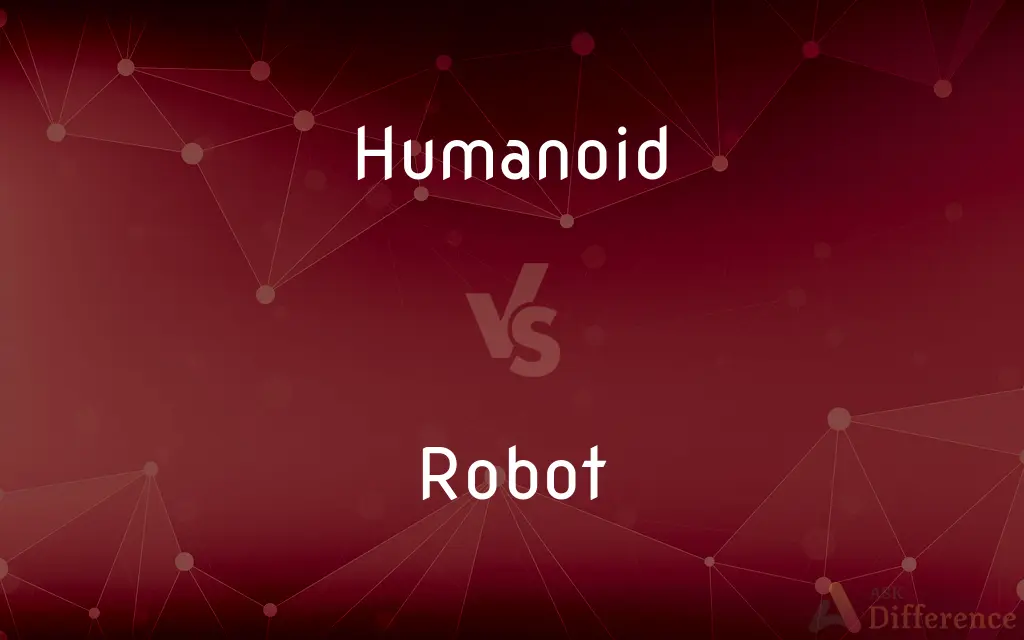Humanoid vs. Robot — What's the Difference?
By Urooj Arif & Fiza Rafique — Updated on March 25, 2024
Humanoids are robots designed to resemble humans in appearance and behavior, focusing on bipedal motion and dexterity, while robots encompass a broader range of automated machines, often task-specific.

Difference Between Humanoid and Robot
Table of Contents
ADVERTISEMENT
Key Differences
Humanoids mimic human appearance and movements, with designs often including a head, two arms, and legs, aimed at performing tasks in environments built for humans. On the other hand, robots can vary greatly in form and function, designed for specific tasks, from industrial assembly to exploration, without necessarily resembling humans.
Humanoids are engineered to replicate human dexterity and mobility, particularly bipedal walking, to navigate environments made for humans. Whereas robots might employ various locomotion methods like wheels, tracks, or multiple legs, depending on their intended use and the terrain they operate in.
Humanoid robots often incorporate advanced AI to interact with humans in a more natural and intuitive way, using speech recognition and facial expressions. In contrast, many robots are programmed for specific, repetitive tasks and may lack advanced AI, focusing instead on efficiency and precision.
Humanoids are typically used in research, entertainment, and as assistance devices, aiming to integrate seamlessly into human environments and societies. Robots, however, are found in a wide range of applications, from manufacturing and logistics to healthcare and home automation, often working in settings not suited for humans.
Humanoids often face challenges in balance, coordination, and complex decision-making due to their human-like form and function. Robots, however, are designed with a focus on reliability, durability, and specialization, optimizing them for specific tasks without the limitations of a humanoid form.
ADVERTISEMENT
Comparison Chart
Appearance
Resembles human form
Can vary widely, not necessarily human-like
Locomotion
Primarily bipedal walking
Includes wheels, tracks, legs, etc.
Primary Use
Research, entertainment, assistance
Diverse, including manufacturing, exploration
Intelligence
Advanced AI for human interaction
Varies, from simple to advanced AI
Design Challenges
Balance, coordination, human-like tasks
Reliability, durability, task efficiency
Compare with Definitions
Humanoid
A humanoid is a robot designed to resemble a human, with a head, torso, arms, and legs.
The humanoid robot was programmed to greet visitors at the reception.
Robot
Robots can have diverse forms, from stationary arms in manufacturing plants to mobile rovers for planetary exploration.
The Mars rover, a sophisticated robot, explores the Martian surface.
Humanoid
Advanced humanoids possess AI that enables them to interact with humans conversationally.
The humanoid responded to questions with natural language processing.
Robot
A robot is an automated machine designed to perform tasks autonomously or with minimal human intervention.
The factory uses robots for assembly line production.
Humanoid
Humanoids often feature bipedal movement, mimicking human walking and gestures.
The research lab's humanoid can navigate stairs and uneven terrain.
Robot
Many robots are designed for specific tasks, such as cleaning, welding, or surgical assistance.
The surgical robot performed the procedure with precision and steadiness.
Humanoid
Humanoid robots are used in various fields, including healthcare, where they assist with patient care.
A humanoid robot was deployed to entertain and engage with children in the hospital.
Robot
Innovation in robotics technology continues to expand the capabilities and applications of robots.
New robots equipped with AI can learn and adapt to complex tasks over time.
Humanoid
Humanoids are instrumental in robotics research, particularly in studying human-robot interaction.
Researchers used a humanoid to study the social impact of robots in public spaces.
Robot
Robots are integral to industries like manufacturing, logistics, and agriculture, improving efficiency and safety.
Robots in the warehouse sort and transport goods, streamlining the logistics process.
Humanoid
A humanoid (; from English human and -oid "resembling") is a non-human creature or being, or a robot, with human form or characteristics. The earliest recorded use of the term, in 1870, referred to indigenous peoples in areas colonized by Europeans.
Robot
A robot is a machine—especially one programmable by a computer—capable of carrying out a complex series of actions automatically. A robot can be guided by an external control device, or the control may be embedded within.
Humanoid
Having an appearance or character resembling that of a human
A small, green, and hideously warty humanoid figure
Robot
Another term for crawler
Humanoid
(especially in science fiction) a being resembling a human in its shape
A three-eyed humanoid
Robot
A set of automatic traffic lights
Waiting at a robot I caught the eye of a young woman
Humanoid
Having human form or characteristics.
Robot
A mechanical device that sometimes resembles a human and is capable of performing a variety of often complex human tasks on command or by being programmed in advance.
Humanoid
A being having human form or characteristics
"humanoids from some far-flung planet" (Robert Brustein).
Robot
A machine or device that operates automatically or by remote control.
Humanoid
Having the appearance or characteristics of a human; being anthropomorphic under some criteria (physical, mental, genetical, ethological, ethical etc.).
Robot
A person who works mechanically without original thought, especially one who responds automatically to the commands of others.
Humanoid
A being having the appearance or characteristics of a human.
Robot
A form of urban dance involving a succession of separate movements executed with precision in imitation of a robot.
Humanoid
An automaton that resembles a human being
Robot
A system of serfdom used in Central Europe, under which a tenant's rent was paid in forced labour.
Robot
An intelligent mechanical being designed to look like a human or other creature, and usually made from metal.
Robot
A machine built to carry out some complex task or group of tasks by physically moving, especially one which can be programmed.
We have a robot in the house that does the vacuuming.
Robot
(figuratively) A person who does not seem to have any emotions.
Robot
(South Africa) A traffic light (from earlier robot policeman).
Robot
(surveying) A theodolite which follows the movements of a prism and can be used by a one-man crew.
Robot
(dance) A style of dance popular in disco in which the dancer imitates the stiff movements of a stereotypical android robot.
Robot
(Internet slang) A habitual poster on the /r9k/ board on 4chan; a member of the /r9k/ community.
Robot
A mechanism that can move automatically
Common Curiosities
Can humanoids perform tasks as efficiently as specialized robots?
Humanoids aim for versatility in human environments, but specialized robots are often more efficient in specific tasks due to their tailored design.
How do robots differ from humanoids?
Robots encompass a broader category of automated machines, which may not resemble humans and are designed for a wide range of tasks.
What defines a humanoid?
A humanoid is characterized by its human-like appearance and movement, often designed to function in environments made for humans.
Do humanoids always walk on two legs?
Most humanoids are designed for bipedal walking to mimic human locomotion, but variations exist depending on the specific application and research goals.
Are humanoid robots common in homes?
While not yet commonplace, humanoids are increasingly being explored for home use in roles such as companionship and assistance.
Are all robots equipped with AI?
Not all robots have AI; some perform simple, repetitive tasks based on pre-programmed instructions, while others use AI for complex decision-making.
How do robots navigate their environment?
Robots use a combination of sensors, cameras, and sometimes AI to perceive and navigate through their operating environments.
What challenges do humanoid developers face?
Developers face challenges in creating humanoids that can balance, move, and interact in complex, varied human environments.
How do robots benefit industries?
Robots increase efficiency, precision, and safety in various industries, taking over repetitive, dangerous, or precision-required tasks from humans.
What roles do humanoids play in society?
Humanoids are used in research, entertainment, healthcare, and as assistance devices, often aiming to integrate smoothly into human social environments.
What advancements are expected in humanoid robotics?
Future advancements may include improved mobility, more natural interactions, and greater autonomy in complex environments.
Can robots and humanoids coexist with humans?
Yes, robots and humanoids are increasingly designed to work alongside humans, complementing human abilities and assisting in various tasks.
How do robots impact employment?
Robots can impact employment by automating tasks, potentially displacing certain jobs while also creating new opportunities in robotics and AI fields.
Do robots always require internet connectivity?
Not all robots require internet connectivity; some operate independently based on pre-installed programs, while others use connectivity for updates and remote control.
Can robots learn and adapt to new tasks?
Robots equipped with AI and machine learning algorithms can learn from experiences and adapt to new tasks over time.
Share Your Discovery

Previous Comparison
Kheera vs. Kakdi
Next Comparison
Trigonal vs. HexagonalAuthor Spotlight
Written by
Urooj ArifUrooj is a skilled content writer at Ask Difference, known for her exceptional ability to simplify complex topics into engaging and informative content. With a passion for research and a flair for clear, concise writing, she consistently delivers articles that resonate with our diverse audience.
Co-written by
Fiza RafiqueFiza Rafique is a skilled content writer at AskDifference.com, where she meticulously refines and enhances written pieces. Drawing from her vast editorial expertise, Fiza ensures clarity, accuracy, and precision in every article. Passionate about language, she continually seeks to elevate the quality of content for readers worldwide.











































